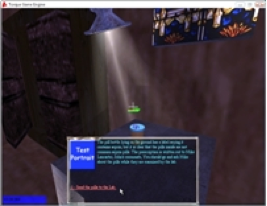We conducted two experiments using task conditions that simulate those of cognitively demanding, interruptive task environments. The Detective Simulation Experiment studied a large number of undergraduate participants who played the role of detectives in a demanding crime-solving simulation. The ER Simulation Experiment asked physicians and senior medical students to treat a set of patients in a simulated ER environments. Although the two populations likely differ from each other in several ways (e.g., working memory capacity, intelligence, performance under stress, and prioritizing and problem-solving skills)i, ii the patterns of local and global effects of interruption were predicted to be similar.
We developed a difficult simulation game, using the torque platform, that participants completed over the course of 100 minutes. This is rich and highly flexible graphical simulation platform that allows developers to build virtual worlds with 3D interactive graphics. Data files generated by running this program are also flexible and highly detailed. The environments are relatively sparse but engaging and easy for a novice to learn to navigate.

Participants were to investigate and solve three complex criminal cases in parallel, collecting up to 119 clues in total, some of which required a query for results after an unpredictable wait. (See “Information Events” below.) Half the participants were periodically interrupted when an awaited item became available, and half completed the task uninterrupted.
The crimes:
- Counterfeit: A reclusive college drop-out turns out to be running an international counterfeit scheme.
- Murder: A man returns from an AA meeting and calls 911 to report his wife, who had been verbally and physically abusive toward him, found dead.
- Terrorism: Three loosely affiliated housemates are caught at a water treatment facility and turn against each other during the investigation.
Each case was associated with its own building in the simulation, and clues were collected by moving from room to room and clicking on icons. Each clue ended by directing the participant to the next required clue. (e.g., “You should visit the potted plant next.”) This allowed us to always know which clue a player intended to collect next, so we could evaluate how well they remembered and fulfilled their goals.
Information EventsSeven clues in each case had special status as “Information Events” (IE’s) that required further analysis (e.g., by being sent out to the proverbial crime lab). The results of these IEs would not be available until after a delay. IE results were crucial for solving the cases (e.g., fingerprints tying people to the scene of the crime). Once an IE was triggered, the current case was frozen and all other clues in it were locked for several minutes. This forced participants to move between cases, ratcheting up the complexity of the task and allowing us to introduce potentially helpful interruptions when a previous case’s IE became available.
To successfully retrieve an IE result, players had to go to a separate location within the simulation and request the IE by name.
i. Shiffrin, RM, Schneider, W. Controlled and automatic human information processing: II. Perceptual learning, automatic attending, and a general theory. Psychological Review, 1977; 84:127-190.
ii. De Groot, AD. Thought and choice in chess. The Hague: Mouton Publishers, 1965.